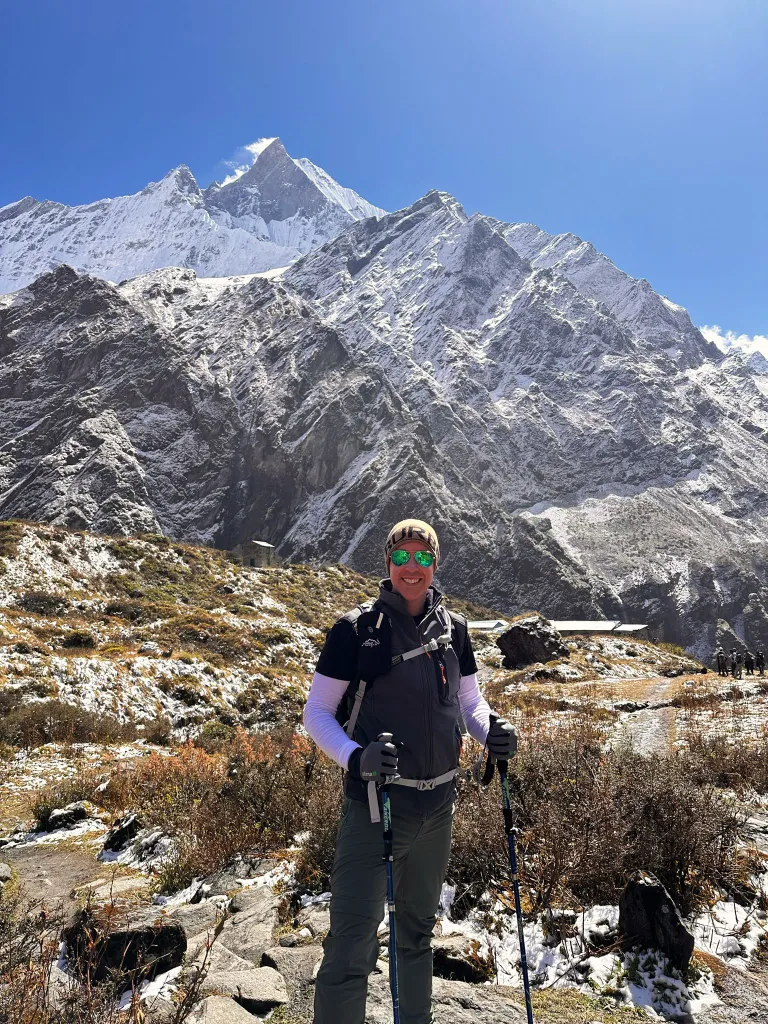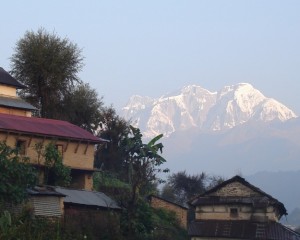Food and Accommodation In Annapurna Base Camp Trek
Food and Accommodation in the Annapurna Base Camp Trek are crucial factors in making the trek successful. Most of the trekkers get amazed and excited to find a very cozy, warm, and homely lodge, mostly known as a teahouse in the Annapurna Base Camp Trek. The meals you eat and the bed you sleep in at night will determine your stamina and energy levels, which are essential for completing a strenuous Himalayan trip. The Annapurna Base Camp Trek and Ghorepani Poon Hill Trek also known as the "Mother Trekking Trail" through the Annapurna region. Every year the trek draws thousands of trekkers from all over the world, especially during the busy summer months.

As a result, there have been notable advancements made in providing guests and trekkers with the best food and accommodation in Annapurna Base Camp Trek. Alike most of the mainstream and popular trekking regions around Nepal, the Annapurna region consists of excellent local lodges and guesthouses where you can spend your comfortable time.
Accommodation In Annapurna Base Camp Trek
In comparison to your walk through the Himalayas, you'll find that the lodging in Kathmandu and Pokhara is far superior to any other place. You will have a lot of options to choose from among the places to stay in Kathmandu based on your budget and the amenities offered by the hotels in the city. However, throughout the walk, this is different. Nearly all of the teahouses provide accommodations with extremely limited amenities. The teahouse is the most typical accommodation in the Annapurna base camp trek.
With the change of time, the facilities provided by the teahouses have been changing. Now, teahouses have all the things they need to meet the basic needs of hikers. The teahouses, which are primarily composed of stone and wood, provide comfortable interior spaces. Typically, there are two single beds in each of the twin-sharing rooms. A two-person occupancy costs about NPR 400 per night, which is a reasonable rate in the Himalayan region. You are, however, strongly encouraged to eat there as well as the foods are mostly hygienic and not much expensive.

You might have to spend significantly more money if you choose to eat somewhere else or decide against it. As you go higher up in the trek, the food becomes noticeably more expensive. The costs paid to the teahouses are worth it as the porters have to carry the materials up on their backs. In the Himalayas, the majority of teahouse proprietors make a living by selling meals rather than teahouse rooms.
All guests traveling to the Annapurna base camp or any other treks are therefore expected to be aware of this reality and behave appropriately. The teahouses may not have amenities like flushing bathrooms or other amenities found in Western countries. Few of them have these amenities. So, this is a fact you must consider. Also, most of the Himalayan Masters advise bringing some wipes and toilet paper, which can also be purchased at the little stores along the trail.
Despite the availability of the teahouses and guesthouses at the camp, you are kindly requested to bring a sleeping bag, as the temperature could drop suddenly and the provided blanket might not be sufficient to keep you warm. However, you have the right to request one additional blanket if necessary but being in the safe zone is much more important.
How is the accommodation for trekkers while trekking in Nepal?
Usually, teahouses are the accommodation while trekking in Nepal. Tea houses are simply mountain lodges or guesthouses aimed to provide services. In the past, teahouses served as a place to serve tea and food to expedition groups mostly and hence were named Tea Houses. The rooms are available at the tea houses are usually on twin sharing basis with or without attached toilets. Communal toilets are offered if toilets are not attached to the room. The rooms in the teahouses have beds with mattresses and pillows. In the teahouses, you get warm blankets. Some places might even offer you additional breakfast.
Tea house in Annapurna Base Camp Trek
The Annapurna Base Camp Trek offers a scenic and marvelous walk. People might think it's difficult to find a nice, lovely, and cozy lodge accommodation at a height of 4,130 meters high. You might be happy to know that the Annapurna base camp trek is only the base camp in the Himalayan range which has a lot of options to give its travelers a place to find comfortable lodges and great meals.
Due to the high altitude and remoteness, accommodation in the Annapurna Base Camp trek is limited to about 4-5 teahouses or lodges. During the peak time to climb the Annapurna Base Camp, trekkers might have to share a room with their partners or group. Though it will be just for a single night, you'll not have to complain much about the place. The amazing views of the marvelous mountain and the panoramic scene can also be enjoyed from your room in the teahouse.

While trekking you might even need to pay the cost of taking a hot shower, using the internet service, or charging your electronic device. As the climate in this region is very unfavorable and unpredictable, you must not expect the availability of electricity all the time. Hence, teahouses won't be able to manage the running hot water showers. Some of the tea houses may manage hot water at an extra charge. It's good to not expect much from the tea houses at higher altitudes.
Food and Water In Annapurna Base Camp trek
Most of the trekking trails in the Himalayas have similar kinds of menus they offer to their clients. The foods and vegetables available in the teahouses are local organic products providing the super energy needed for the long walk throughout the day. You are suggested to focus more on what the body needs rather than what it likes during the hike.
You might know that the food you eat or the water you drink during the trek determines the amount of stamina in your body. As stamina is very important throughout the trek as it is essential to make the trip remarkably successful. You can also buy some snacks, bottled water, and some energy-providing chocolates that might be helpful to get energized for a short period. You are recommended to carry enough water from the teahouse or you can also use the water purifying tablets to purify the water available in the taps on the way to the Annapurna base camp. As the bottled water costs increase as you climb high, you can take a refilled water bottle and fill it with the water available on the trail. You need to drink plenty of fluids while you trek.
It's important to maintain your body's hydration level to avoid altitude sickness which is often experienced more if the body lacks water. The water available in the taps may not always be edible. It might cause diarrhea or dysentery later in the day. Hence, use water-purifying tablets.

Mostly all the teahouses on the trail will offer you similar kinds of food. Dalbhat, a national dish in Nepal, is common everywhere. It comes with a set of rice, lentils, or beans soup added with vegetable curry and pickle. The food is considered to be one of the most nutritious foods in Nepal. Besides Dalbhat, you can also get different foods that will be offered for breakfast, lunch, and dinner.
Breakfast during the Annapurna Base Camp Trek
Often breakfast is considered the most important and first meal of the day which is consumed to break the long fasting from the previous night. While you’ll be on the trekking trail, you’ll need a lot of stamina to walk for long hours. Hence, your first meal must be healthy, hygienic, and heavy. The breakfast time for the trekkers starts early around 7 am so you can begin the trek early from 8 am. If your group is small, you might need to order breakfast beforehand. With us, you don’t need to worry about these as the guides will be there with you.
You can get a hot beverage, a cup of coffee, or tea with you for your breakfast. You can get an amazing breakfast in Landruk, Chomrong, Himalaya, and Jhinudanda enjoying the amazing view of the mountains and landscape. Pizza is also popular in the Himalayan region. Some of the teahouses might offer you Americano, Cappuccino, and Coffee cake besides the normal drinks. Be ready to hear the very expensive price of the drinks at the higher altitude.
Check out the list of varieties of food you’ll be provided as breakfast in the Annapurna Base Camp trek. Make sure you take the food that best helps you to make your day pleasing.
Lunch During Annapurna Base Camp Trek
You get an amazing opportunity to explore the local Nepali cuisine in any of the Himalayan treks. You get enough stamina to trek for long 5-6 hours a day if you choose to take the right food. Lunch is often considered the main course of meals in Nepal. Hence, most of all teahouses prepare Dalbhat as the major item for the lunch along with many other varieties available. Most of the trekkers, national or international prefer to take Dalbhat for their lunch. It must be the nutrient and the price that have attracted many trekkers. An advantage is that once you order a set of dal baht, you can add as much as you desire without any extra charge. The items that we can get for lunch are
Rice:
Often Rice is available as veg. or nonveg. Dalbhat. Some of the tea houses may offer a Thakali Khana set. Rice with chicken curry, Rice with veg. Curry, Mixed fried rice, and Egg fried rice are also common.
Noodles:
A warm bowl of Veg. fried noodles, Egg fried noodles, Mixed fried noodles, and Fried noodles with cheese can make your body warm after the climb in the cold areas.
Spaghetti:
Teahouses now offer varieties of foods like Spaghetti with cheese, Spaghetti with tuna or tomato sauce, or Spaghetti with veg. The sauce is much preferred by international guests.
Pasta:
Pasta has been the favorite of many trekkers. Pasta is available in flavors like vegetable fried pasta, mixed macaroni, pasta with cheese, pasta with egg, pasta with tomato sauce, and fried pasta with cheese.
Pizza:
Himalayan pizza is a famous dish in the Himalayas. Mixed pizza, Mushroom pizza, and Chicken pizza are pretty common these days.
Burger:
If you prefer a burger for lunch, mix burger, veg. Burger, chicken burgers, hamburgers, and hot dogs might be available.
Dumpling:
Dumplings served with hot tomato sauce are much-preferred food to keep the body warm in cold weather. Veg., buff, chicken, cheese, potato, and paneer dumplings are available.
Dinner during the Annapurna base camp trek
After a tiring task of the day, dinner is a pleasant food. Most of the teahouses in the trail offer similar kinds of menus for lunch and dinner. You might get the Dalbhat for the dinner too but other varieties might be also available. Besides breakfast, dinner, and lunch, teahouses also provide other options. Nepal Vision Treks offers you a complete package for Annapurna Base Camp. Follow our website for new updates.
FAQs
- How is the food at the Annapurna Base Camp?
Annapurna Base Camp Trekking Food
The majority of the breakfast options at ABC Trek are chapati, bread, pancakes, french toast, and eggs with tea or coffee. A staple is a traditional Dalbhat from Nepal. Rice is referred to as Bhat, and dal is lentil soup.
- How much does the food at the Annapurna Base Camp cost?
You will need the permit as you will be going into the Annapurna Conservation Area. Your hiking company arranges for all permissions. Due to its usual length and level of difficulty, the Annapurna Base Camp Trek is not the most expensive trek in Nepal. The prices for the trek might range from USD 700 to 1000.
- What is the best way to get ready for the Annapurna Base Camp?
Prior to your Annapurna base camp trek, you should engage yourself in multi-day training or hiking stated as in the training guidelines. The closer your trek is, the more crucial it becomes. You will be walking for several hours at a time. Depending on the day, you might also pack a down jacket or a fleece.
- Does the Annapurna Base Camp have internet access?
Most locations on the Annapurna Base Camp Trek have a strong internet connection. Some hotels even offer free Wi-Fi, however the majority charge between USD 1 and USD 4 per use for both Wi-Fi and mobile charging.
- Is oxygen required to climb Mt. Annapurna?
Being at a high altitude means you are at higher risk of altitude sickness danger, severe weather, and a chilly climate. The Annapurna trek is challenging to demand due to the combination of all these variables. It is an accomplishment in and of itself to be able to perform this without oxygen. The Mt. Annapurna trek needs oxygen.
- Are sleeping bags required for the Annapurna Circuit Trek?
For the Annapurna Circuit trek, you'll need a winter sleeping bag that can withstand below-freezing temperatures. You can pack a lightweight sleeping bag with a temperature rating of about -10° or -6°C for a fall hike.
- What is the cost of the hike to Annapurna Base Camp?
Costs for the Annapurna Base Camp Trek begin at USD 650 per person.
If you want to include a flight from Kathmandu to Pokhara, you'll have to pay $200 more to get from Pokhara to Kathmandu. You will need to pay an additional fee if you want to upgrade your lodging in Pokhara and Kathmandu.
- What season is ideal for a hike to Annapurna Base Camp?
The optimum months for hiking on the Annapurna Circuit are generally regarded to be October and November or April and May. When traveling to high altitudes during these two seasons, it is often not too chilly because the weather is clear and dry.
- What level of fitness is needed for the Annapurna Circuit?
a modest level of fitness
A moderate level of fitness is required for the Annapurna Base Camp Trek. You'll need to walk on difficult paths for up to 6-7 hours per day, at a very higher elevation. If you've never gone trekking or hiking before, or if you're not physically fit, the thin air at this altitude may be difficult for you.
- Which Annapurna is the most difficult to climb?
Strom is very common in the high mountains. Particularly, the south face is frequently cited as the world's most hazardous climb. Helicopter tours have made it possible to visit the Annapurna range from the Base Camp without making the arduous journey.






